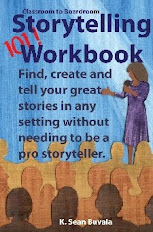To consistently illustrate the techniques, I’m using the image of Jack, of “And the Beanstalk” fame, for this article. This process applies to any and every setting where you are telling stories, from business to bassinet.
1. Go with the literal “story” introduction.
 |
| Introducing Characters: Meet Jack |
“Once Upon a Time, there was a boy named Jack who lived with his mother in a very small house.”
Here you get right to the point, no need for the audience to catch up with you. Your audience does not need to guess what you are talking about as you lay out the scene. However, the “Once Upon a Time” lead-in will most likely cause your audience of business or teenage folks to mentally leave the room.
2. Use a situational introduction.
Start your story from anywhere but an expected beginning and put Jack in a situation that is from the depths of your story:
“From the middle of the tree-thick, reaching-to-the-heavens beanstalk, young Jack looked down upon the boyhood home that he still shared with his mother.”
Here the audience needs to work a bit harder as you give them something to process.
3. Share your character’s internal monologue.
We all have some type of self-talk. Share Jack’s in a manner like this:
“’What happens if I fall off this crazy plant? It was only a pile of beans yesterday. Mama is right: maybe I do need to think before I act.’ said the teenage Jack to himself, as he climbed the giant beanstalk growing outside the kitchen window of the cottage where he lived with his poor mother.”
Here you let us into the thinking patterns of your character, in most cases sharing with us their struggles. This type of intro is better for older audiences that have good abstract thinking skills.
4. Let another character talk to or about the character.
Let one character speak to another character about what they see, hear and feel.
“’ Jack, in your whole 12 years of your life, you have never done something this foolish. When you come down, I am locking you in your room for the rest of your life!’ screamed Jack’s mother as she stood outside of their small cottage. She was concerned, after all, as it was not every day that a boy could climb a beanstalk that reached to the sky.”
5. Compare the character to the audience.
Think about how the audience can relate to some aspect of the character and use that to connect the story to their experiences. For an audience of kids,
“Twelve-year-old Jack, in my story, may be just like you. He wanted to experience fantastic things. When he looked out the window of the cottage he shared with his mother, he saw the bottom of a giant beanstalk, thick as a tree and reaching to the sky. It was time for this poor boy to have an amazing adventure.”
Business Example.
Okay, you have twisted my arm. Here is one business introduction tied to the examples above. Remember, this is a hypothetical situation and I am writing words intended to be spoken aloud, not read.
“My client, Jerry Johnson, was leaning over the intensive-care hospital bed of his 25-year-old wife thinking that this type of illness only happened to ‘old people.’ It was really hard to clear his head of the ambulance siren from two hours ago and the beeping medical devices now.”
Do not get caught up in the formulas presented here, especially for business or corporate storytelling. They are guides. There is.no.storytelling.formula for everyone. Overall, your stories for business don't need to follow some "mythic journey." I will be writing more about that soon.
So, have we been introduced?
*****
This is the official blog of storyteller K. Sean Buvala. Learn more about his latest workshop at message15.com. Photo: Public Domain http://www.loc.gov/pictures/item/2002723369/





No comments:
Post a Comment